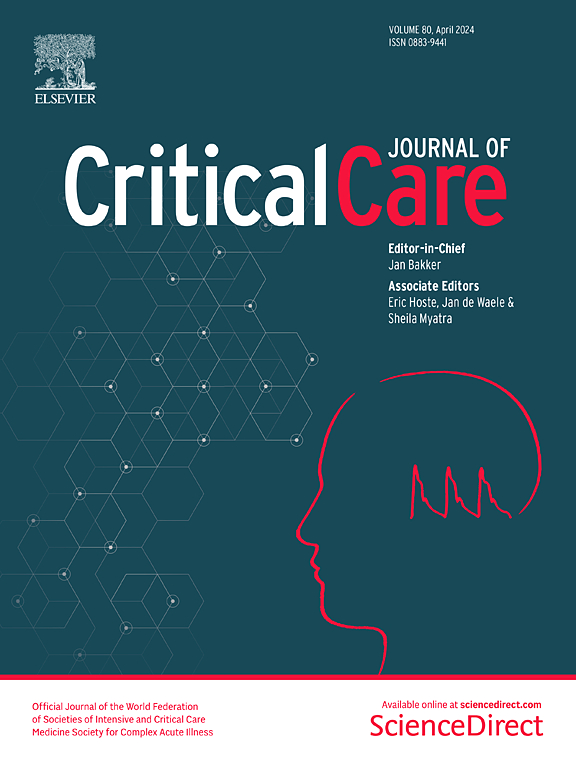ORAKLE: Optimal Risk prediction for mAke30 in patients with sepsis associated AKI using deep LEarning
IF 8.8
1区 医学
Q1 CRITICAL CARE MEDICINE
引用次数: 0
Abstract
Major Adverse Kidney Events within 30 days (MAKE30) is an important patient-centered outcome for assessing the impact of acute kidney injury (AKI). Existing prediction models for MAKE30 are static and overlook dynamic changes in clinical status. We introduce ORAKLE, a novel deep-learning model that utilizes evolving time-series data to predict MAKE30, enabling personalized, patient-centered approaches to AKI management and outcome improvement. We conducted a retrospective study using three publicly available critical care databases: MIMIC-IV as the development cohort, and SiCdb and eICU-CRD as external validation cohorts. Patients with sepsis-3 criteria who developed AKI within 48 h of intensive care unit admission were identified. Our primary outcome was MAKE30, defined as a composite of death, new dialysis or persistent kidney dysfunction within 30 days of ICU admission. We developed ORAKLE using Dynamic DeepHit framework for time-series survival analysis and its performance against Cox and XGBoost models. We further assessed model calibration using Brier score. We analyzed 16,671 patients from MIMIC-IV, 2665 from SICdb, and 11,447 from eICU-CRD. ORAKLE outperformed the XGBoost and Cox models in predicting MAKE30, achieving AUROCs of 0.84 (95% CI: 0.83–0.86) vs. 0.81 (95% CI: 0.79–0.83) vs. 0.80 (95% CI: 0.78–0.82) in MIMIC-IV internal test set, 0.83 (95% CI: 0.81–0.85) vs. 0.80 (95% CI: 0.78–0.83) vs. 0.79 (95% CI: 0.77–0.81) in SICdb, and 0.85 (95% CI: 0.84–0.85) vs. 0.83 (95% CI: 0.83–0.84) vs. 0.81 (95% CI: 0.80–0.82) in eICU-CRD. The AUPRC values for ORAKLE were also significantly better than that of XGBoost and Cox models. The Brier score for ORAKLE was 0.21 across the internal test set, SICdb, and eICU-CRD, suggesting good calibration. ORAKLE is a robust deep-learning model for predicting MAKE30 in critically ill patients with AKI that utilizes evolving time series data. By incorporating dynamically changing time series features, the model captures the evolving nature of kidney injury, treatment effects, and patient trajectories more accurately. This innovation facilitates tailored risk assessments and identifies varying treatment responses, laying the groundwork for more personalized and effective management approaches.ORAKLE:利用深度学习对脓毒症相关AKI患者的mAke30进行最佳风险预测
30天内主要肾脏不良事件(MAKE30)是评估急性肾损伤(AKI)影响的一个以患者为中心的重要指标。现有的MAKE30预测模型是静态的,忽略了临床状态的动态变化。我们介绍了ORAKLE,这是一种新颖的深度学习模型,利用不断发展的时间序列数据来预测MAKE30,从而实现个性化的、以患者为中心的AKI管理和结果改善方法。我们使用三个公开的重症监护数据库进行了回顾性研究:MIMIC-IV作为开发队列,SiCdb和eICU-CRD作为外部验证队列。确定了在重症监护病房入院48小时内出现AKI的脓毒症-3标准患者。我们的主要终点是MAKE30,定义为ICU入院30天内死亡、新透析或持续肾功能不全的综合指标。我们使用Dynamic deepit框架开发ORAKLE,用于时间序列生存分析及其对Cox和XGBoost模型的性能。我们使用Brier评分进一步评估模型校准。我们分析了16671例MIMIC-IV患者,2665例SICdb患者和11447例eICU-CRD患者。ORAKLE在预测MAKE30方面优于XGBoost和Cox模型,在MIMIC-IV内部测试集中auroc为0.84 (95% CI: 0.83 - 0.86) vs 0.81 (95% CI: 0.79 - 0.83) vs 0.80 (95% CI: 0.78-0.82),在SICdb中auroc为0.83 (95% CI: 0.81 - 0.85) vs 0.80 (95% CI: 0.78-0.83) vs 0.79 (95% CI: 0.77-0.81),在eICU-CRD中auroc为0.85 (95% CI: 0.84 - 0.85) vs 0.83 (95% CI: 0.83 - 0.84) vs 0.81 (95% CI: 0.83 - 0.84) vs 0.81 (95% CI: 0.80 - 0.82)。ORAKLE模型的AUPRC值也显著优于XGBoost和Cox模型。在内部测试集、SICdb和eICU-CRD中,ORAKLE的Brier评分为0.21,表明校准良好。ORAKLE是一个强大的深度学习模型,用于预测AKI危重患者的MAKE30,该模型利用不断变化的时间序列数据。通过结合动态变化的时间序列特征,该模型更准确地捕捉到肾损伤、治疗效果和患者轨迹的演变本质。这一创新有助于进行量身定制的风险评估,并识别不同的治疗反应,为更个性化和更有效的管理方法奠定基础。
本文章由计算机程序翻译,如有差异,请以英文原文为准。
求助全文
约1分钟内获得全文
求助全文
来源期刊

Critical Care
医学-危重病医学
CiteScore
20.60
自引率
3.30%
发文量
348
审稿时长
1.5 months
期刊介绍:
Critical Care is an esteemed international medical journal that undergoes a rigorous peer-review process to maintain its high quality standards. Its primary objective is to enhance the healthcare services offered to critically ill patients. To achieve this, the journal focuses on gathering, exchanging, disseminating, and endorsing evidence-based information that is highly relevant to intensivists. By doing so, Critical Care seeks to provide a thorough and inclusive examination of the intensive care field.
 求助内容:
求助内容: 应助结果提醒方式:
应助结果提醒方式:


